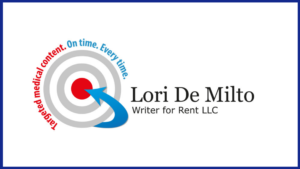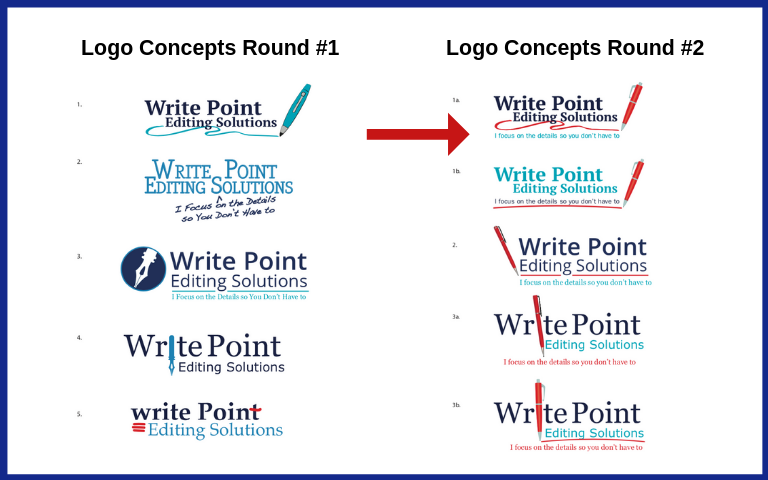Do You Know the Best Way to Develop an Awesome Freelance Brand?
 Successful freelancers know that clients choose freelancers who look and act professional. And they know that a unique, visually engaging brand is part of a professional image. That’s why successful freelancers hire a professional designer to develop their brand.
Successful freelancers know that clients choose freelancers who look and act professional. And they know that a unique, visually engaging brand is part of a professional image. That’s why successful freelancers hire a professional designer to develop their brand.
A unique, visually engaging brand helps clients quickly get to know and trust you. And it helps you stand out in a sea of freelancers.
But you’ll only get a unique, visually engaging brand when you work with a professional designer who has experience in branding and logo development for freelancers.
Showcase Your Freelance Business with Your Brand
Your logo and tagline are the main ways your brand highlights your freelance business and makes you memorable. A logo is an image, symbol, or other design to identify your services. Your company name, tone of voice, and colors are also part of your brand.
“A logo helps you connect with your potential client. It can easily and quickly tell someone what you do,” says Brian Corchiolo, owner of bcp creative. Brian designs and develops amazing logos and websites. He developed both of my logos and websites (freelance business and Mighty Marketer).
And your tagline is a memorable phrase or sentence that helps your target audience(s) understand what you do. It’s used as part of your logo.
Help clients understand your story
The best logos have an image, symbol, or other design. Brain recommends the use of an icon related to your work in a logo, because icons are a great way to help people understand what you do.
Icons are generic images that the designer will customize in your logo. Examples of icons are a pen for an editor or a test tube for a medical writer.
“Icons are everywhere, and the meaning of icons is well understood,” says Brian. “If you choose the right icon, it helps tell your story and gives potential clients a basic understanding of what you do.”
Some logos just use the freelancer’s company name and tagline. This can work too, but it’s not quite as memorable as a logo with an image.
Here’s my logo, which uses a bullseye icon with an arrow in the center. The bullseye icon with an arrow was my idea but Brian customized the image for me. So the design of my logo, and my tagline as part of it, are unique. “It’s easy to start with an icon and make it your own,” says Brian.

Hire a “Real” Designer to Develop Your Brand
When you work with a professional designer like Brian, you get a customized, visually engaging logo. This lets:
- Clients quickly get to know and trust you
- You stand out in a sea of freelancers.
“A professional designer will guide you in developing a logo that you love that works for your business,” says Brian. But if you use a site like fiverr, your interaction with the designer will be limited and your logo won’t be customized to your business.
“You’ll get what you pay for,” says Brian. “These people are taking a few stock ideas and putting your name into it. Your logo will look like everybody else’s logo,” says Brian.
The low price that may have seemed so attractive will actually cost you a lot more than hiring a professional designer would have—because if you have a me-too logo, you won’t be attracting high-paying clients.
Find the Right Professional Designer for Your Brand
Getting recommendations from people you know and trust, especially other freelancers, is the best way to find a professional designer for your logo.
I found Brian and bcp creative by asking some of my freelance colleagues for recommendations. And now I recommend Brian to other freelancers regularly. Nearly all of Brian’s clients come from word of mouth.
When you see a freelancer’s logo that you like, email him/her to ask who designed it. Also ask about your colleague’s experience working with the designer. Some designers are very talented, but they don’t listen to what you want.
What to Do Before You Contact a Professional Designer
Before you contact a designer, do some research to start figuring out what you like and don’t like. The more you can tell your designer about what you want, the closer he/she will come in the design of your logo. If you do this, then you’ll save you time, effort, and maybe money.
“Explaining graphics is hard,” says Brian. “That’s why I ask people to send me anything that they like.”
Review the logos of other freelancers and other businesses. When you see something you like, take a screen shot and put it in your brand file. Let your designer know what you like and don’t like about each logo. Also make notes about the colors you like and don’t like.
You can also do some research on icons that you might want to use and send them to your designer. Use sites like iStock or Pixaby to search for the right icon for your brand.
Brian says that by looking at all of the logos a freelancer sends him, he can start to figure out what the freelancer is looking for.
How to Work on Your Brand with Your Designer
Your logo needs to work on your website, in your email signature, on your business cards, and in other marketing you might do. The colors and design need to look good on the web, including on smartphones, tablets, and laptops, and in print. For example, orange and green are popular colors that can be difficult to get right.
And icons work because they’re simple. “The more detailed you get, the more an icon starts to break down. It may look good on a computer but not as good on a smartphone screen or a business card,” says Brian.
So while you should be happy with your logo, you also need to listen to your designer’s advice about what works best in representing your business. If you love two colors that don’t work well together or won’t look good online or in print, don’t insist on using them.
Convey your key messages with your brand
“My job is to give you the logo you love but with my guidance on how to convey your message,” says Brian.
When Brian is working on a logo, he talks to the freelancer to get a sense of what he/she likes and doesn’t like, including colors. And he reviews whatever the freelancer sent him. Then he does some research on good colors for the freelancer’s business. For example, blue and orange are good colors for freelance medical writers and editors. Brian tries to include the color(s) the freelancer likes, as long as it will work as part of the logo.
While professional designers do know what makes for good and bad design, some always think they know what’s best for the client. “A lot of designers design things for themselves. I want the logo to reflect the client and what the client wants to accomplish,” says Brian.
Be Honest and Provide Specific Feedback
Brian starts by developing a few different logo concepts for review, each with different options. He includes a few concepts that the freelancer didn’t ask for or think about. Usually, the client likes parts of one concept and parts of another.
Here’s an example of concepts from Kathleen Labonge’s logo, which Brian designed. The icon in her logo is a pen, but Brian used it in a creative way.
 Kathleen chose the logo with the red arrow on the left. Click here to see how it looks on her website.
Kathleen chose the logo with the red arrow on the left. Click here to see how it looks on her website.
Be honest about what you like and don’t like, and why. And provide specific feedback. Your professional designer isn’t a mind reader. He/she needs guidance from you to develop an effective logo.
Get a brand you love
It’s okay to say so if you hate something. “I’m used to clients telling me about things they don’t like. It doesn’t hurt my feelings,” says Brian. “If you’re not honest, you won’t get the best logo.” In fact, not being honest is one of the biggest mistakes that freelancers make when working with Brian.
“If you want to do something I don’t agree with, I’ll tell you why I don’t think it’s a good idea,” says Brian. “I’ll make suggestions to try to do what you want to do in a way that works.”
And the more specific you are about what you don’t like and why you don’t like it, the better your logo will be. “I like the client to be specific, for example, I like this blue but want the red to be deeper. Or take the icon from logo #5 and put it in logo #1,” says Brian.
Then Brian creates another round of concepts for review. Once the freelancer and Brian agree on a few concepts, Brian suggests asking other people for feedback. Other freelancers and clients, if you’re close enough to them, can help you decide which logo will work best for you. Make sure you only ask people who do good marketing for feedback.
Stand Out in a Sea of Freelancers
The final logo represents your vision for your brand. But it’s much stronger, because Brian (or another professional designer) has created a unique, visually engaging logo that will help you stand out in a sea of freelancers.
Learn More About Freelance Brands
How to Stand Out in a Sea of Freelancers: Your Freelance Brand
How Eva Stabenow Attracts the Right Clients with her Freelance Brand
How Kristin Harper Shows She’s a Professional with Her Freelance Brand
How Kathleen Labonge Boosts Awareness with her Freelance Brand
11 Steps to a Business Name that Will Make You Memorable
How to Win High-Paying Clients with Your Freelance Website